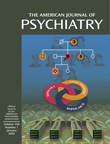To the Editor: Drs. Kapur and Seeman proposed an interesting hypothesis that fast dissociation from D2 receptors explains the action of atypical antipsychotic agents. I propose that the lower affinity—the lower ratio of kon (association rate constant) to koff (dissociation rate constant)—of D2 receptors explains the action of atypical antipsychotics. I will discuss this hypothesis on molecular and systemic levels, as the authors did.
The authors’ hypothesis derives from two intriguing experimental findings at the molecular level. First, differences in the affinity of antipsychotic agents for D2 receptors are driven by differences between their koff, not between their kon. Second, atypical antipsychotic agents have much higher koff (fast koff) at D2 receptors than do typical antipsychotic agents. On the basis of these findings, the authors hypothesized that the action of atypical antipsychotic agents may derive from faster dissociation from D2 receptors and explained that “when the concentration of endogenous dopamine rises in response to physiological stimuli, drugs like clozapine (which have a nearly 100 times faster koff [than haloperidol]) decrease their occupancy much faster and provide much more access to surges of dopamine” (p. 364). According to receptor binding kinetics, antipsychotic agents and endogenous dopamine compete with each other to occupy D2 receptors because of their affinities for D2 receptors. Since the affinity of an antipsychotic agent is determined by the ratio of kon to koff, the degree of unoccupied receptor accessible to endogenous dopamine is determined not only by how quickly the drugs dissociate from D2 receptors but also by how slowly the drugs associate to D2 receptors. Thus, antipsychotic agents with slower kon can provide more access to surges of dopamine, as antipsychotic agents with faster koff do. Although the atypical antipsychotic agents that the authors have tested so far showed faster koff, it is always possible that newer atypical antipsychotic agents have low affinity and slower kon, rather than faster koff. Thus, faster koff is not the exclusive criterion for the atypical action of antipsychotic agents, but the lower affinity and faster koff and/or slower kon are the criteria for the atypical action of antipsychotic agents.
At the systemic level, the authors proposed that the much more transient occupancy of the D
2 receptors by atypical antipsychotic agents is associated with transient prolactin elevation and fewer extrapyramidal side effects
(1). The authors claimed that this transient effect is accounted for by faster k
off. However, the transient occupancy of D
2 receptors by single doses of atypical agents may not exactly reflect the pattern of D
2 receptor occupancy when patients reach a plateau after multiple doses of the drugs, by which time D
2 receptor occupancy would be greatly prolonged. Another potential problem with the theory for the transient occupancy of D
2 receptors by atypical antipsychotic agents is its relationship with the onset of clinical response. A large body of evidence indicates that dopamine cell activity is dramatically reduced and that, subsequently, release of endogenous dopamine is greatly reduced within 2–3 weeks of drug administration
(2). Clinical response is usually shown within 2–3 weeks of the administration of antipsychotic agents. At this time, atypical antipsychotic agents may occupy D
2 receptors much more because the synaptic concentration of dopamine is greatly reduced. Thus, D
2 receptor occupancy by the atypicals at or after this point in time may be more relevant to the drugs’ antipsychotic action.

